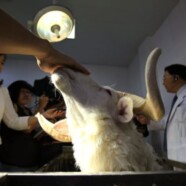Electricity From Organ Movement Powers Body Implants
Someday, implanted medical devices such as a heart pacemaker may be powered by the movement of the body’s organs. Researchers have demonstrated the potential of natural organ motion to do just that.
So-called piezoelectric materials produce electrical current when they are stressed or squeezed. Imagine, for example, electricity being created by stretching a rubber band.
John Rogers and colleagues at the University of Illinois Urbana-Champaign have created a low-level current device by attaching piezoelectric materials to flexible ribbons of plastic. When the device was applied to moving organs, Rogers said it generated little bursts of electric current.
“And that turns out to be a useful characteristic because when mounted on an organ like the heart, or the lung or the diaphragm, the natural motion of the organ then creates this bending motion,” he said. “And that current can be stored in a battery, a tiny chip-scale battery, and then be used to power biomedical implants like cardiac pacemakers.”
Other potential biomedical devices that might be powered using piezoelectric current include heart monitors and nerve stimulators. At present, these devices are powered by batteries that require surgery to replace.
Scientists tested their piezoelectric ribbons on the human-sized organs of cows, pigs and sheep. Researchers report their system generated up to eight volts of electricity – enough electric current to run a cardiac pacemaker.
In laboratory experiments, they found the devices remained stable after being bent back and forth more than 20 million times, suggesting piezoelectric ribbons could reduce or eliminate the need for batteries in biomedical devices.
Rogers is looking forward to human clinical trials. “It’s definitely years into the future, but we’re optimistic. I would say so far, so good.”
An article on piezoelectric ribbons is published in the journal Proceedings of the National Academy of Sciences.

